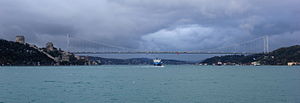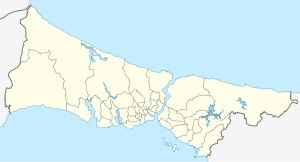Fatih Sultan Mehmet Bridge
Coordinates: 41 ° 5 ′ 28 ″ N , 29 ° 3 ′ 40 ″ E
| Fatih Sultan Mehmet Bridge | ||
|---|---|---|
| Convicted | Highway O-2 | |
| Crossing of | Bosporus | |
| place | Istanbul | |
| construction | Suspension bridge | |
| overall length | 1510 m | |
| width | 39.4 m | |
| Longest span | 1090 m | |
| Clear height | 64 m | |
| opening | 1988 | |
| planner | Freeman Fox & Partners | |
| toll | toll | |
| location | ||
|
|
||
The Fatih Sultan Mehmet Bridge or Second Bosphorus Bridge ( Turkish Fatih Sultan Mehmet Köprüsü , FSM for short , or İkinci Boğaziçi Köprüsü ), named after Sultan Mehmed II , is the second of three bridges in Istanbul that span the Bosphorus and so connect the European with the Asian part of the city. It was opened in 1988 and is located about five kilometers north of the Bridge of the Martyrs of July 15, 1973. The bridge, located on the O-2 motorway and only approved for motor vehicles, serves not only for inner-city traffic but also as a link in the motorway connection from Edirne to Ankara .
description
The Fatih Sultan Mehmet Bridge is a suspension bridge with four lanes separated by a median and a footpath on both sides. The almost horizontal bridge deck connects the districts on the high banks, the districts directly on the bank are deep under the bridge. It crosses the Bosphorus with a clearance height of 64 m, so that large ships such as aircraft carriers and cruise ships can pass through.
Unlike the first Bosphorus Bridge, its pylons are not on the bank of the Bosphorus, but on the high bank. As the motorway leading to the bridge extends to the pylons on both sides, there are no bridge fields outside the pylons, only the suspension cables stretched over 210 m from the pylons to the anchor blocks .
The total length of the structure measured from anchor block to anchor block is 1510 m. The span between the pylons is 1090 m. The Fatih Sultan Mehmet Bridge thus has a bridge deck that is 16 m longer than the first Bosphorus Bridge, but does not require any long outer bridges.
Its steel pylons also have no substructure apart from the foundations. They start on the high bank just below the bridge deck and are therefore only 111.1 m high (including the feet in the concrete bases). They tower over the road by 98.2 m. Similar to the first Bosphorus Bridge, the two posts of the pylons are connected and stiffened by a crossbar halfway above the roadway and by a crossbar between the peaks.
As with the first Bosphorus Bridge, the bridge deck consists of an aerodynamically favorably shaped, flat hollow box made of sheet steel, the shape of which was tested in the wind tunnel in order to offer little resistance to the wind and, due to its profile, to avoid vibrations and aeroelastic fluttering .
The bridge deck is a total of 39.4 m wide and only 3 m high. It has a 30.8 m wide flat top that merges with a 1.5 m wide slope at both edges into the somewhat lower 2.8 m wide footpaths. The flat, just 23.8 m wide underside of the box girder is connected to the outer edges by a long slope. The footpaths therefore look like an upturned wing.
As with all large suspension bridges, the suspension cables consist of parallel wire ropes . In contrast to the first Bosphorus Bridge, the planners used the usual vertical hangers again.
history
The Fatih Sultan Mehmet Bridge was designed by Freeman Fox & Partners , who had already planned the first Bosphorus Bridge and, in the meantime, the Humber Bridge . The Turkish engineering company BOTEK Bosphorus Technical Consulting Corp. was also involved in the planning and construction supervision.
The Fatih Sultan Mehmet Bridge was built by a consortium of three Japanese ( Ishikawajima-Harima Heavy Industries , Mitsubishi Heavy Industries and Nippon Kokan ), an Italian ( Impregilo ) and a Turkish company (STFA). The groundbreaking ceremony was on May 29th Completed in 1985. The construction costs of the entire Kinali-Sakarya Highway project , which included the bridge construction, amounted to 130 million US dollars . It was officially used for the first time by the then Prime Minister Turgut Özal on July 3, 1988 during the opening ceremony.
toll
The Fatih Sultan Mehmet Bridge is a toll road . Since 2004, only payment via RFID system has been possible; payment with cash has been abolished, as has toll booths occupied by people.
Web links
- Fatih Sultan Mehmet Köprüsü (PDF; 268 kB) Document of the Turkish road administration with information and pictures of the bridge as well as with plan sketches. (Turkish)
Individual evidence
- ↑ The dimensions in this section are taken from the plan sketches in the document of the Turkish road construction administration (see web links).
- ↑ BOTEK Bosphorus Technical Consulting Corp.
- ↑ Marcel Prade: Les grands ponts du monde . Deuxième partie, Hors d'Europe. Brissaud à Poitiers. ISBN 2-902170-68-8


